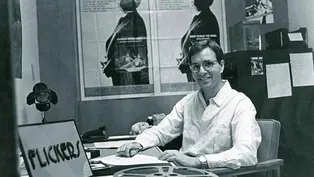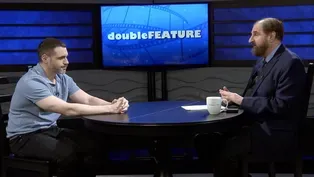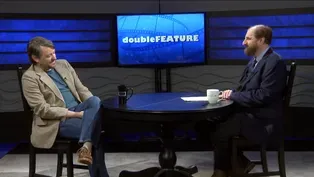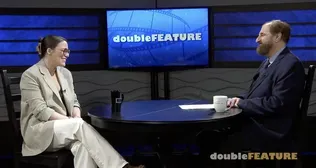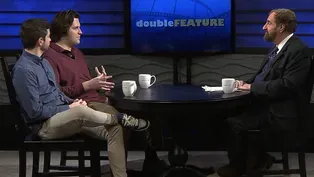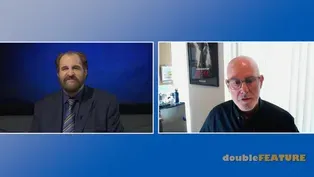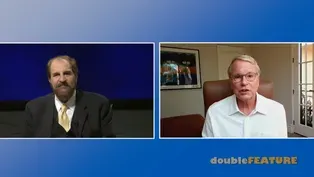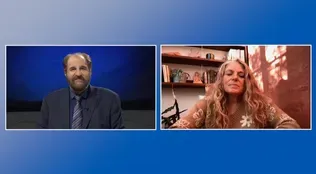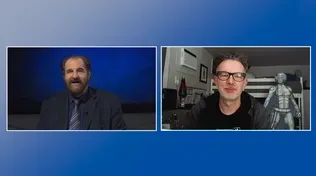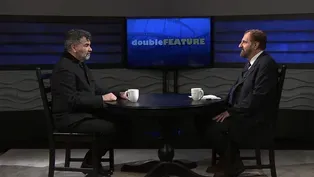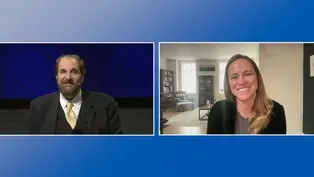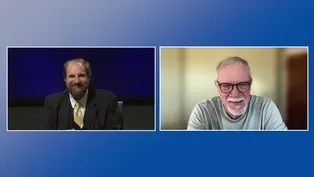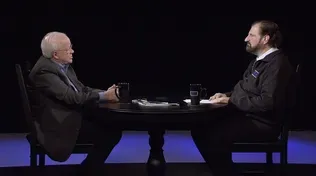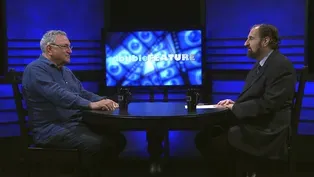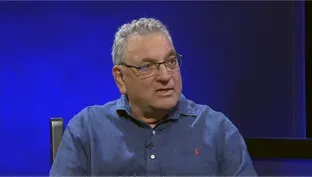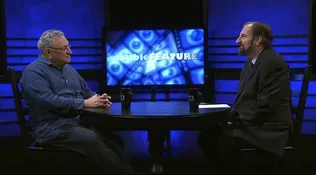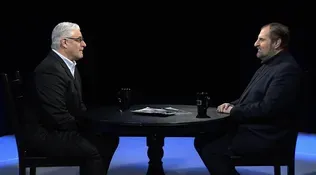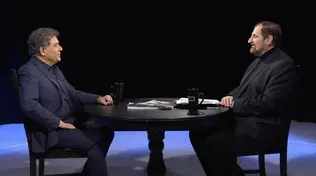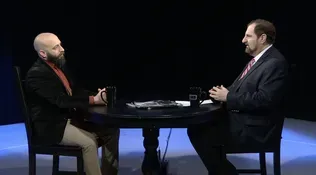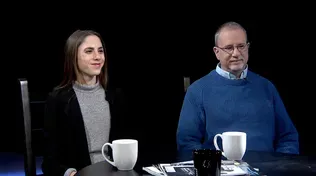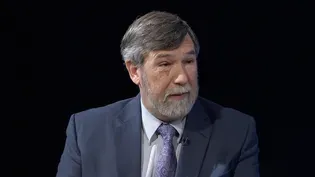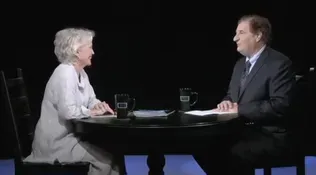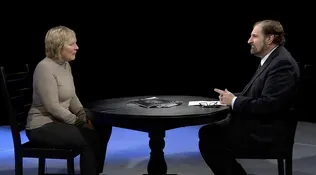
Interview with Martin Mercer
Clip | 44m 30sVideo has Closed Captions
Steven Feinberg interviews storyboard artist, Martin L. Mercer.
Steven Feinberg, executive director of the Rhode Island Film and Television Office, interviews storyboard artist, Martin L. Mercer. Mercer has worked on storyboards for multiple series and films, including "Loki," "Suicide Squad," "The Nun," and "Aquaman."
Problems with Closed Captions? Closed Captioning Feedback
Problems with Closed Captions? Closed Captioning Feedback
doubleFEATURE is a local public television program presented by Rhode Island PBS

Interview with Martin Mercer
Clip | 44m 30sVideo has Closed Captions
Steven Feinberg, executive director of the Rhode Island Film and Television Office, interviews storyboard artist, Martin L. Mercer. Mercer has worked on storyboards for multiple series and films, including "Loki," "Suicide Squad," "The Nun," and "Aquaman."
Problems with Closed Captions? Closed Captioning Feedback
How to Watch doubleFEATURE
doubleFEATURE is available to stream on pbs.org and the free PBS App, available on iPhone, Apple TV, Android TV, Android smartphones, Amazon Fire TV, Amazon Fire Tablet, Roku, Samsung Smart TV, and Vizio.
(energetic music) - Hi, I'm Steven Feinberg, Executive Director of the Rhode Island Film and Television Office.
Tonight I am so honored to have my adopted British brother from another mother.
He's a phenomenal storyboard artist, concept artist, creature creator.
He's worked on films like "Rise of The Planet of the Apes," the TV series, "Loki," "Aquaman," you name it, he's worked on it.
He is a superb artist, a great friend.
Martin Mercer, welcome to "doubleFEATURE."
- Thank you, Steve, lovely to be here.
- See, I knew that that accent wasn't from Texas.
That's definitely a British accent.
- Yes.
- You're here, now you're in Los Angeles, right?
I'm sure you're working away on another production.
And I wanna thank you for taking the time away.
But Martin, you and I met about 25, maybe 30 years ago.
- Yeah.
- But I know your career started when you were 18, I think you started working at Pinewood Studios, right?
- Well, when I was 18, in school, in the UK you can stay onto the sixth form and then you go onto college.
And I was gonna go to art college, but I had an opportunity to work on the film "Labyrinth," which was a Jim Henson production and had David Bowie in it.
And at the time, my dear friend, his father was George Gibbs, George Gibbs, unfortunately, has passed away a few years ago, but he was a mechanical effects supervisor and he'd done "Indiana Jones" and "Brazil" and just a whole load of films.
And he kind of took me under his wing.
And so, he offered me a role as a trainee tea boy on "Labyrinth" in the mechanical effects department.
And that was at Elstree Studios.
- [Steven] Oh, Elstree Studios.
- Which is in Borehamwood, yeah.
- And Elstree is where they did the "Indiana Jones 3, "The Last Crusade."
And I know you worked on that rat sequence, right?
Didn't you work on the rats that were on fire in the water underneath Venice?
- Yes, this was before CG and any of that type of work.
So everything had to be made.
And the rats, we had a guy called Dave Chagouri, who was a very clever foam specialist, and he made the bodies of the rats.
And then we haired them, we actually put a fur on them, and we had the little rudder underneath, and a propeller, which was driven by an elastic band.
- You would wind them up, right?
You'd wind wind them up?
- Yes, yes.
We'd all wind them up with electric drills and they would be on this frame, which was on the track under the water.
And so, when the director, Mr. Stevens Spielberg said, "Action," we would pull this trolley underwater and all the rats would be moving like that, you see moving through the water.
And at the same time, we had a couple of guys with long rods with a butane on fire.
And that would go to a butane tank and on action they would release the valve and you get this big ball of fire 'cause that was what was driving the rats.
And of course, Indy dives underneath the coffin to prevent from getting burnt.
- Right, and they use the real rats for the closeups of Indy underneath.
And so those rats would funnel into the, those were real rats that would go on the actors.
But then those wide shots were those mechanical rats that you guys created?
So none of the animals got hurt.
- Well, the wide shots were mechanical, but also we did have real rats.
There was a gentleman called Mike Culling who provided all the animals.
He was an animal expert.
And so, the rats were placed in the set in amongst the skeletons and everything.
And of course, over the time they would multiply, which is what they did.
So the rats actually multiplied.
And our mechanical ones did the water stuff, and the real rats were swimming in the water.
And also Mr. Spielberg was like, "Well, I need more rats.
"I need more rats on the walls."
So we would end up nailing these rubber rats all over the walls.
We would just have to cover the walls.
And so, when they moved the lights and you had the flame, it looked like the rats were moving, yeah, on the wall.
- What a first experience for a young person in Britain.
That must have been amazing to you.
- Yeah, it was brilliant.
I know Harrison Ford, he was very pleasant.
He would go, "Call me H, you know, guys just call me H." And he would go into his trailer and just, he was a very friendly guy, very nice.
- And how was it when you first saw the movie on the big screen after all your work was done?
- Well, it was very exciting 'cause they always have the premiers, or I didn't go to the premier, but they'd have the crew screening and the premiers, they have them in Leicester Square, which is the main theatrical sort of district in London.
And so that was fun to go there on Sunday, and everybody's lining up and go in and see it.
I was a little bit disappointed 'cause I didn't get a credit.
But George said, "Yeah, sorry, Mart, "I didn't have any room."
So I was a little bit bummed at that.
But nonetheless, it was great to see it all come together.
- You know what's interesting, Martin, I was talking to a film historian the other day, and we were talking about credits and all, and how back in the day, you know, a film like "Jaws" wouldn't have that many credits.
And actually, I was talking to Joe Alves, and he was talking about credits and how on certain films that he had worked on, he wouldn't get credited.
And then as time has gone on, you know, more and more, whether it's through the unions, more and more folks are getting the well deserved credits.
But back in the day, it would be one credit for art director, and no one who did storyboards or anything would get credits.
And so, like, thankfully now you're getting the recognition you deserve.
So was it at Elstree or Pinewood in England when you met Clive Barker, because I know Clive Barker, he was a writer of horror and he had an impact on your career, correct?
- Correct, so, I mean, Clive first came to prominence with a series of books called "The Books of Blood."
And Stephen King saying, his quote was, "I've seen the future of horror.
"And its name is Clive Barker."
And of course, once you get a quote from Stephen King, who is the god of horror, right?
Once you get a quote from him saying that your career is on the up and up, and Clive wrote those books, and they're amazing books even to this day, and he had a deal with, I think it was New World Pictures at the time, and they allowed him to direct "Hellraiser."
Robin Vidgeon was the DOP, Director of Photography.
And I think it was a very small fee for Clive, and he had to sell his rights as well.
But nonetheless, he got to direct "Hellraiser," and that was a massive hit.
And it's beautifully photographed and it became very well known for the Cenobite characters.
- [Steven] The Pinhead, right, Pinhead?
- Yeah, he was known as the Lead Cenobite at the time, but he became recognized as Pinhead, which was played by the actor Doug Bradley.
And you had those three main characters, and he became, you know, very well known for those.
And the film did really well.
And so, then Clive got a deal to direct his film "Cabal," which became "Nightbreed."
And anyway, so I'd seen "Hellraiser."
I was like, "Oh, I'd love to work for those people."
And at the time I was working model making and set building at the time there for a company in London called Asylum Models & Effects.
So I was like, "Oh, I wonder "how I could get involved there."
And I'd heard that they were gonna be doing "Nightbreed."
A couple of model makers told me, "Yeah, we're going up to Pinewood, "we're gonna work for a company called Image Animation."
So I found Image Animation, and I phoned them up, and I managed to get an interview, and my dad, bless him, drove me up there to Pinewood, which was about 30 miles away.
And I interviewed there, showed them my portfolio, and I was one of the few people back then that actually had worked on proper films.
Most of the guys that got there had been like me, had been doing it in their rooms at home and just, you know, fans.
And anyway, so I managed to get an interview and they said, "Yeah, okay, "well, keep calling, keep calling.
"We're not sure when we're gonna start."
So for eight weeks every week I rang them up, I rang up a guy called Geoff Portass, who was the second in command there.
Bob Keen owned the company, and eventually I got hired as a sculptor, background sculptor.
- Wow.
And do you know who designed the Pinhead character?
Was that Clive himself or did somebody do that character?
- No, no, Clive was an excellent artist.
I mean, if you are able to see the original "Books of Blood" covers, he illustrated those.
I actually have one here over there, but he illustrated it.
He's a phenomenal artist.
And so, all the characters you see in "Nightbreed," he designed, and so we would get these sketches and you had the main creature guys who were there, Steve Painter, Neill Gorton, Paul Jones, Mark Coulier, who was an Oscar winner, Paul Spateri, who just won an Emmy for "The Last of Us."
All these guys were there and they sculpted and made the stuff, and as I did myself.
- And did you have a mentor at that time?
- Well, my mentor was George Gibbs, and so I was still in contact with George, and actually when I was at Pinewood, "Alien 3" was about to start.
And George said, "Oh, Martin, "I've got you an interview there."
So I went up, I didn't get the job, but nonetheless, it was nice to meet the guys.
But yeah, so I still knew George then, but then, you know, Clive was really cool.
He was very approachable.
He would come into the workshop and he could see I liked drawing.
And so, he actually allowed me to do three covers for the Marvel comics at the time.
Did the "Nightbreed" versions.
So he got me a job doing a couple of covers, you know, they're okay now, but it was great for him to do that.
- And it also gave you confidence, I'm sure, that your work was being well received, right?
- Yeah, no, it was very nice to have that 'cause you always, I mean, especially us Brits, you know, we're not very confident of ourselves, really.
A bit shy, so.
- Sure, sure.
- You know, it's nice to get a boost.
- And you're starting out.
And so, then was it that, you went from "Nightbreed" to "Lord of Illusions" and came out to Los Angeles?
Was that the transition?
- Yeah, the transition happened because our company, Image Animation, which was Bob Keen and Geoff Portass' company, and we were the main crew by that time, we were doing all these movies like "Warlock," "Warlock 2," "Hellraiser 2," "Hellraiser 3," "Candyman," the original "Candyman."
So, and all these films were being, they weren't being done in Europe and the UK like they are now.
They were all being done in America in Los Angeles mostly.
And so Bob decided to move part of the company to Los Angeles.
So I came out and looked for a workshop and was one of the people that started it.
And when he started "Lord of Illusions," the actual work that our company was doing wasn't a lot.
He was dividing it amongst other people like Steve Johnson, XFX at the time, and Tony Gardner and all these other guys who were amazing artists.
And so, our work wasn't much.
And I remember we were having a meeting and Clive said, "Oh, I need storyboards.
"I need somebody to do storyboards."
And I just put my hand up and said, "I'll do 'em, Clive."
And 'cause I fancied a change, you know, 'cause makeup effects, especially back then, was very messy and dirty, it's not very good for the skin, and so on and so forth, so I fancied a change.
- And you hadn't done storyboards yet, right?
- No, I'd done, when we did makeup effects, we had to design the shots to show the directors how to shoot these puppets and so on and so forth.
So I had a little bit of experience, but no, not really.
I'd read a magazine, you know, so.
- (laughs) That's great, that's great.
So you did storyboards for "Lord of Illusions,"?
- Yes, I would drive to Clive's house in Beverly Hills every day.
And Clive had a couple of houses, 'cause he was doing quite well by then.
And one of them was his art studio.
So I'd drive up to his house, park there and go into his studio.
And there was another artist there called Marc Baird.
And Marc Baird is an amazing artist.
And we became friends and yeah, for six months, literally just sat in Clive's house and drew the boards.
And Clive would do the storyboards.
Clive would get up every day and write for two hours, and then he would do his drawings and that.
So he was very dedicated to what he did.
He deserves all his success, worked very hard.
He comes from Liverpool, very poor background, so did really well.
- Yep, now, when you would be drawing, I remember, 'cause you and I have worked on a few projects together, you listened to a lot of techno music at the time, when you were working with Clive, would you have music on or would you draw without music?
- No music.
- No music?
- No, no, yeah, 'cause it was me and Marc in the room there.
So we would just talk to each other and just discuss the scene or Clive would come in.
So no, no music.
- Okay, do you prefer to draw with music on, or do you prefer no music?
- No, because I have tendinitis, ringing ears, so it is actually better for me to just not listen to anything and just focus on the work.
Other guys, they can have movies on and all that.
I dunno how they do it, I can't do that.
I have to just look at what I'm doing and get on with it.
- 'Cause I know when I'm sometimes working on my screenplays, and that's how I made my living before, I would always have music on.
I don't know, it kept me going all the time.
Martin, so I mean, you've won awards.
So we're gonna jump around a little bit.
- Okay.
- So recently you won, let's see, in 2022, you won the Art Directors Guild Production, desired award, for the TV series "Loki."
The episode is called "Glorious Purpose," correct?
- [Martin] Mm, mm-hmm.
- Can you talk about that and where you are now?
And then we'll go back.
We'll do almost like a "Memento" style of interview.
- Yeah, right, without the ending, hopefully.
- Right, right.
- Yeah, well, "Loki" was great because my dear friend Darrin Dellinger, who is an exceptional story artist and animatic specialist, animatics is where you animate the boards altogether, so you're literally looking at an animated film, and he'd worked for Marvel for years.
And so they always would say to him, "Oh, you know, "we need an artist for this."
And he recommended me for "Loki."
And so I went up to Disney, and that's who owns Marvel.
And Marvel was in the Disney building.
And I interviewed there and there was one interview, and I got through that.
And then went to another interview, which was by phone where I spoke to the director, who was a British director, Kate Herron.
And she directed before that a show called "Sex Education," which is very funny.
- [Steven] Yeah.
- And she directed some episodes of that.
And anyway, she pitched her view of "Loki" and she got the job and it was all very exciting.
And so I interviewed her on the phone, we got on very well.
And then I went to Disney again and met her there.
And it was being done in Atlanta.
And these days you can do everything online, so I didn't have to go to Atlanta.
So basically Kate would prep and give me shop lists.
Every director is different.
Some do shot lists, some draw pictures like Ridley Scott, Ridleygrams, and some don't, you know, they let you get on with it and then they look up what you've done and make their changes.
- [Steven] Yep.
- So Kate was very judicious in having lists of shot lists.
And so that's how we started.
And we started with a scene on the train.
Loki gets on the train and all this stuff happens.
And it was a huge sequence actually, as things do, they got changed and cut down.
And that's basically what happened there.
Now, during that show, COVID-19 really started to ravage across the country and the world, and they were still shooting.
And what they had to do, they had to actually keep me on all through that period, because now it became a case of, right, well, we got six actors in a room, but we've gotta keep them six foot apart.
How do we shoot that?
And so anyway, so they used my boards to determine how they would shoot that and the angles.
And so that was a good show.
Kept me going through COVID, fortunately.
- Wow, when you were going to have your interview with her, Kate, did you know who's going to interview you?
And then did you see those programs, "Sex Education," so you were prepared to know her work or had you not done that?
- No, because I didn't know.
- Okay.
- Who the director was.
They didn't tell me.
- Yep.
- And of course, once I'd met her on the phone, spoke to her on the phone, I then looked her up and obviously, and I'd seen "Sex Education" already.
So once I knew she was on that, and I just looked up the episodes that she directed just to see, oh, what did she need boarding?
And there was one episode where somebody's on a bike, and they go down a hill and they have an accident and that.
So, you know, so I always do my research best I can.
- Let me ask you something.
This is a unique question.
You've worked with a lot of, I mean, I don't know how many shows you've done, movies, TV shows, you've done everything from, you know, video games like "Twisted Metal, Black," you've done comedies, you've worked with every different director and actor in fantasy.
When your storyboarding, let's say it's a Ridley Scott film, or in this case it was Kate, and let's say you're somewhat familiar with their work, or do you, when you storyboard, do you try to think like them?
Or are you just thinking like yourself?
Are you saying, this is how I would do it, or this is how I think knowing how they like to move the camera, this is maybe how I think they would want to do?
Like, do you almost become like an actor in a way?
- What happens, it's varies because like the thing I'm doing now, just doing a project with reshoots, I've been able to look at what they've shot, and therefore I can see how that director moves the camera.
And therefore when I board, I think okay, I've seen, okay, they like tracking shots and then they like leading in from one foreground object into a distant object.
So that goes into my brain.
But a lot of the times, look, this job is about servicing a vision in order to get the whole crew on board with what needs to be seen and what needs to be done.
That's what it is basically, it's like doing a map.
That's how I see it, so I'm not directing.
However, what does happen is a lot of the stuff when I'm given a scene and it's like, well, here's the script, have a crack at it, I just go by instinct.
Now touch wood, knocking on my old head there, it seems to work.
Most of the times when I've gone by instinct, it has been received well.
When I look at the films at the end, I can see, oh look, okay, I can see "my" shot in there, you know, the one that I drew.
And obviously, you know, that goes through all the processes and in the end the director looks at that and it's his or her call, you know?
- Right, right, you also love to do concept art, right?
You've done some really neat concept art.
Is that sometimes more enjoyable than storyboards?
- Well, most of the concept art came from the fact that I, 'cause I used to do makeup effects, so I had some friends who were working on shows and they needed some images, and so I would do those.
And a couple of films I've done conceptual art for as a whole, such as the "Paranormal Activity," the fifth version of that.
That was all concept art, didn't do any boards.
But I actually do enjoy doing boards more, to be honest with you.
And also conceptual art now with artificial intelligence, machine learning, it's days.
Yeah, they're kind of numbered in a way.
So I'm glad I do boards and even that's gonna be affected by it, that's for sure.
- When you did the TV series "Star Trek, Discovery," what were you doing, designing costumes?
- What happened with that was my friend Paul Jones did the first series, just series one.
And they needed some concepts, sort of background aliens, and also Demter I think her name was, she had a control device here.
- [Steven] Yes.
- So Paul engaged me to design that, we had to do it very quickly.
We spent a whole weekend using our phones, texting and drawing.
I did some concept art for that and a background aliens.
So, and costume wise, yeah, I did about a month on that as well for the first series, costume designer.
- Wow, let me ask you, because when you and I met about 25, 30 years ago, you were doing all of the work was pencil, right?
It was pretty much pencil work.
And then I remember there was a concern you had because the storyboard tools were starting to evolve and getting, you're doing more on the computer and you were taking classes.
And can you talk about the evolution of how you started and how it's evolved over time and some of the tools of the trade?
'Cause there might be some folks who are watching tonight that are phenomenal artists and are interested in becoming storyboard artists.
What are some of the tools that you now need and how has things evolved and how have you become more educated?
- Right, well, when I started, everything was pencils, markers, pens.
I worked on a show called "Asteroid," which is for NBC.
And that was, I would draw it out in pencil, go to Kinko's at the time, the color copy service.
As you know, we did loads of your stuff there.
And I would photocopy it.
So then you would've a black line that was indelible, and then with colored pencils and markers, you would go over that and you would use color to bring it and, you know, create the illustration.
It all started to change for me when I worked on "Twisted Metal, Black" for Sony Computer Entertainment.
And there, for the first time I saw this tool called Photoshop.
And you know, I didn't even know how to scan an image, they had to teach me, and how to scan and then color in Photoshop.
But even actually on "Twisted Metal, Black," most of my stuff was done using markers and pen, as it happens.
But that was the first introduction to it.
And I then worked on a show called "Mr. and Mrs. Smith," and I was on that for about a year and a half.
- [Steven] That was the Brad Pitt Angelina Jolie film.
- [Martin] Yeah, directed by Doug Liman.
- [Steven] Right, who had done "The Bourne Identity."
- Yes, yes, that's right.
And so Doug, you know, wanted loads of storyboards, and there was another artist, unfortunately, I've forgotten the guy's name, but he was very good and he was doing all his stuff digitally.
So I was like, Ooh, you know, so, and actually my friend Marc Baird, who was working on "Daredevil," and I did a few weeks on "Daredevil," and he was totally digital.
He was using what they call a Wacom tablet, which is a tablet and you know, you have a pen.
And back then that was really eye-opening.
So it was an evolution where I just, I forced myself to, okay, I've gotta get a computer.
So I brought an Apple computer, it was bloody expensive at the time, and a tablet.
And I just forced myself to, you know, to do this.
And actually a lot of the older artists in the industry at the time were really bucking at it, and just a lot of them retired and just didn't wanna know.
But what could you do?
You know, I wasn't retirement age, so I just plowed through with it.
And over time, one of the ways I do, I keep sketchbooks, you see, I keep sketchbooks like this, loads of sketchbooks.
And I would use a pen basically because it was very similar to electronic Stylus.
It was, you know, hard and unforgiving in that way.
That's how I trained myself.
- So you needed something tactile.
- What's that?
- You needed something tactile.
You needed that physical property.
- Yeah, because you know, with the iPad, this is the iPad and you've got the Stylus, you know, it's very plastic on plastic.
And when you draw with a pencil, you know, it's not like that.
It's giving and it's soft and you can feel it biting into the paper.
We don't get that with digital work.
- Right, right, right.
And I remember the time you were a little nervous because you knew that there was going to be, you had to climb a mountain to really rediscover these new tools or discover these new tools.
And I remember it was a little scary 'cause you were jumping in, you know, into the big pool.
- Yeah.
- Right, the deep end.
- And I did take classes as well.
Our union, which was the Art Directors Guild, IATSE, they did provide classes at Valley Village College.
And so, I did Photoshop, I did After Effects.
And I just, you know, I'm not the brightest bulb on the tree, so it was hard work to try and get this stuff, but I managed to scrape by.
- Yeah, yeah, at this time, Martin, when you're doing all of this and you're evolving and gaining all this knowledge, is that when you're doing "X Files" or had you done "X Files" already?
- "X Files" was just, again, it was just pen on paper.
All my stuff was pen on paper and marker.
I hadn't gone digital at all then, no.
- Yep, and then one of the, you also did "Iron Man 3" is another film you did and "Silent Hill."
Can you talk a little bit about working on those shows?
- Well, "Iron Man 3," literally my friend Jim Magdaleno, who's a excellent artist, he couldn't do it for a few weeks.
He was some family troubles and things, so he got me on there for two weeks.
So I just did two weeks on it, and that was fine.
It was very rushed and you know, I just had to do what I was told and I did that, and that was the end of that (laughs).
- And then "Silent Hill."
- Now "Silent Hill" was a lot of fun because I'd met Roger Avary and we actually developed quite a friendship and I would hang out with him and he had all these projects he wanted to do.
And so I would do all this stuff.
And he wrote the first "Silent Hill."
He was due to direct the second one.
So I initially started with him doing designs for Pyramid Head, who is the guy with the big huge pyramid and the sword.
One of the ideas, we actually wanted to see what's inside Pyramid Head when he takes off his mask.
So I did loads of concepts for that.
And then eventually Roger didn't do it.
There was another director whose name, unfortunately, I've forgotten, Michael, I think, so he did it and I worked with him doing conceptual illustrations based on the new character, this woman with two bladed hands and spiked heels and stuff.
So that was quite fun, just behind.
- I think I dated her, I think I might have dated her.
- Possibly (laughs).
- Let me ask you, you also got nominated by the Art Director's Guild for "Maleficent."
- [Martin] Yes, "Maleficent 2."
- [Steven] "Maleficent 2," can you talk about that and what that project was like and how you got involved?
- Yeah, the director of that was Ronning Joachim, and he is, I believe, a Swedish director.
He'd done one of the "Pirates of the Caribbean."
And so I met with him the Hotel Marmont, which is a sort of a place where all the stars.
- Chateau, Chateau Marmont.
- That's it, that's the one, thank you.
And so I went there, met with him, and we had a coffee.
And he said, "Right, I need this opening sequence.
"Here's the script, off you go.
"Can you have it done by Friday?"
So I went back to the studio at Disney and worked on it, and then went back to the hotel and presented it with him.
And he goes, "Okay, great, straight onto Previs."
Now what Previs is, it's a 3D computer rendition of a sequence.
Usually we provide the storyboard ideas first and then Previs guys, they then take that and carry that away.
Now they might not like me saying that, but that's what happens.
Anyway, so they took that and they made the Previs rendering from it.
And then he went off and had to deal with casting, and so on and so forth.
And so then, as a lot of times happens, you deal with the visual effects studios.
And so I was dealing with them and boarding various sequences and that was about for three months.
And then they said, "Okay, we're moving to the UK now, "so we're gonna shoot the rest of it there.
"So thank you very much."
So that was the end of my role on it there.
But it's very strange to think, oh, okay, going back to my home country, but I can't, you don't want me to work on it.
So that was quite fun.
- Right, right, right.
- Yeah.
- And how did you feel like when you saw the final product of that?
'Cause you get nominated for it.
I mean, you get nominated for that work.
- Well, what happens is, is when you get nominated for that work for the Art Directors Guild is it's the production designer and their team.
And so Patrick Tatopoulos was the production designer for that.
And so I was part of his team.
So what happens is, in the nominations, you get Patrick and then you get a concept guys and you get storyboard guys.
So yeah, it was always nice to have that, you know, a little bit of recognition fluttering down to where we are.
- Now, I remember when you got this gig, because you know how much of a huge fan I am, when you got the "Planet of the Apes" gig, what was it like working on the "Planet of the Apes" movies?
Well, "The Rise"?
- Yeah, "The Rise of the Apes."
Well, when we were engaged to do it, it was a pitch.
So our boards were being used to present to the studio and say, "Hey guys, you know, do you wanna do this?"
you know, "Planet of the Apes," brilliant movie, which Charlton Heston, we all love that classic.
- [Steven] Sure.
- And the subsequent series.
And so we were doing pitch boards, and whilst we were doing the pitch boards, it was like, Hey, you're a green, you've got a green light, you're a go.
So that was quite exciting.
And again, worked with the director.
He had a quite a strong vision of what he wanted.
And so I remember I did a scene in Muir Park, I think, in San Francisco where the apes are hiding in the trees.
- [Steven] Yeah.
- And so on and so forth.
So that was quite fun 'cause I do love "Planet of the Apes."
- Didn't you also do the sequence on the bridge?
- A little bit, but mainly it was when they went to Africa and they poached the apes from there.
And just many different bits and pieces.
- Right, that was a treat.
And then you've worked on "Aquaman" and the sequel of "Aquaman."
Can you talk about what those experiences have been like for you?
- Yeah, they were great fun because I was always a fan of the director, James Wan, because I remember going to a screening of "Saw," which was his first massive hit.
You know, he'd come from Australia.
This film was made for like, under a million dollars and it was a huge hit.
And so he was doing a talk at the theater where they showed "Saw."
So I was like, oh, he is really cool, you know, he's very young, very cool.
Anyway, so I managed my friend James Doe, who works with James Wan a lot.
James Doe is a storyboard guy.
And he said, "Oh, Martin, they're looking for somebody else, "so I'll put your name in."
And so I went for an interview.
I met James Wan, and his office was filled with maquettes and models and all the cool designs from "Aquaman."
I was like, oh, I just felt like, you know, when I was 18 again, you know what I mean?
- [Steven] Right, yep.
- I was just so into it.
So hopefully he saw some of that enthusiasm.
And I got hired and my main was the arena fight between Orm and Aquaman.
And then James again was like, "Look, I like wide shots.
"I like my action in wide and just run with it."
And so I'd started to run with it, and then James had come round and look and say, "Well, can you do this, can you do that?"
And so, we developed that scene.
And, you know, I might have an idealize.
Oh, wouldn't it be cool if they started running on the shield of one of the big statues?
And he was like, "Yeah, okay, that's good, let's do that."
And so that was very enjoyable, yeah.
And I worked at Warner Brothers in Burbank on that for about six, seven months.
- Now, would they Previs that, your work on that afterwards and take it to the next level?
- Yeah, yeah.
- Are you part of that process or does it just leave your hands and then, or do you see any or do you have any input on that?
- No, our job is to map it out.
And then the Previs guys, they build all the assets, and then one, they have the board and they can see the direction.
And now when the Previs guys work, and they might go, oh, or you know, James might go, "Okay, well, we should do it "on a 50 here, 50 mil lens."
And so Previs can do that.
They can show you what a 50 mil lens looks like and so on.
And oh, we're gonna have him on a flying rig here and Previs can put the rig in.
And so, I don't have anything to do with that.
My thing is I provide, here's the map and then those guys run with it with the director.
- Martin, you've recently worked on, I believe it's "Bad Boys 4."
- [Martin] Correct.
- [Steven] How has that experience been working on "Bad Boys 4," the newest sequel of the movie?
- Yeah, it was really good fun.
It was a very kind of accelerated production.
The guys, the two directors and the director of photography were from Belgium.
And they had some issues with the third act as, you know, that happens quite a lot in productions, usually the third act.
And so they wanted some ideas basically of how to do certain scenes.
And so, they engaged me and straight away it was right in there.
Usually on the first day, you can just relax and just read the script and do your paperwork, but this time it was like, "No, we need this "and can we have it by the end of the day?"
But it was a challenge and they were very nice.
And I was on it for about 10 weeks and they were happy with what was done.
And I'm looking forward to seeing the movie.
It should be fun.
- Was that filmed in Florida or was that filmed in Los Angeles, or where was that?
- I think that was filmed in Atlanta, and some stuff in Miami, and yeah, I believe.
I didn't go on location, but what was nice was the guys actually sent me a photo of my boards all laid out on the set and they ticked them off.
You see, they'd strike them off as they go through them.
So that was fun.
- Right, right, right.
Can you share what you're working on now, Martin?
Or is that top secret?
- No, I can't really reveal the title, but it's science fiction horror.
And it is reshoots, it was reshoot, it was made in London.
But they're doing some reshoots and yeah, it should be cool.
Very exciting to be involved in this one.
- Now, do you have a particular genre you love to work in or not?
- No, I like horror.
I mean, I love horror, science fiction, action, adventure.
But you know, I mean, even comedy, I did a film called "Mall Cop 2" and it was a lot of fun.
You know, it was a lot of fun.
It's actually quite a fun film and there was loads of gags in there.
So, you know, as long as it's action and it's, you know, using the brain to work out sequences, I'm quite happy to do it.
- Yep, and what else are you working on?
Are you working on any of your own stuff right now?
- Well, I do have my podcast.
- Yes, tell us about it.
- Now that's called "The Wrong Side of Hollywood" and it's quite, it's very English and it's very cynical, and bitter, and grumbly and twisted, but all in a very lighthearted Monty Pythonesque, the full Monty without the striptease manner.
And it's with my mate James, who you know.
James Mastroianni, we've known each other since we were kids.
And so because we came from England, we moved here, we've ended up living literally next door to each other, and during the pandemic and the downtime, you know, we have such a good rapport with each other, we thought, how can we video?
And then somebody said, "Well, why don't you do a podcast?"
So we started to do that where we would describe our adventures of being foreigners in America, in California and Los Angeles.
We describe British food and our experiences of food in California.
And we would interview people, what I would call in the trenches, i.e.
people who don't get the limelight so much like voiceover actors.
We interviewed somebody who worked on all the big effects films in the '80s.
So that's a kinda side project I've been working on.
- And his brother, one of your podcasts, his brother directed the play about "Jaws."
- Yes.
- What is it called?
"The Shark is Working," is that what the name of the play is called?
- "The Shark Is Broken."
- "Is Broken," right.
- And Guy Masterson, he directed it and it was written by Robert Shaw's son.
- [Steven] Yes.
- And he, Robert Shaw, kept diaries during the making of "Jaws," and his son decided to a write a play from it and it was in London and it went onto Broadway.
- [Steven ] Right.
- And yeah, Guy directed it and Guy is James' brother.
And another thing with James is his uncle was none other than Richard Burton.
- Wow, Richard Burton.
- Yeah.
- The Richard Burton?
- The Richard Burton, yes.
- Well, it's really neat because we had, as you know, we had Joe Alves here at the "doubleFEATURE."
And so it's kind of neat how, you know, that story's come around and we try to get to Martha's Vineyard.
They always have these different anniversaries, you know.
- Yes.
- A "Jaws fest.
So I'm looking forward to seeing that play.
But I wanna say my brother from another mother, my British brother Martin, I wanna thank you so much for taking time.
I know you've got a lot going on, very busy schedule.
And I want to thank you for your super talent, your friendship, your love, your passion at what you do, and for educating the audience, and then giving our audience an opportunity to see some of your artwork tonight on this show.
So I wanna wish you the very best of health and continued success and I look forward to seeing you soon, and maybe having you back on if you enjoyed your experience here.
- I'd be delighted.
And you are absolutely fabulous.
I think Rhode Island is extremely lucky to have you.
You've always talked about Rhode Island, you've always, when we first met.
And I think you've done an amazing job and very inspiring.
Yeah, so totally a brother to me and I really appreciate your friendship, and thank you for this opportunity.
- Thank you, pal.
And I hope everybody listens to your podcast as well.
What's it called?
- It's called "The Wrong Side of Hollywood."
Wherever you get your podcasts.
I hope it doesn't insult anybody, but it's just a laugh.
It's just fun.
- Right, you're doing it for fun.
And your art work, as we'll be showing some of that as well.
Thank you pal, lots of love.
- Cheers, Steve, love you mate.
- Yep.
(energetic music) (energetic music continues) (energetic music continues) (energetic music continues)
The Legacy of George T. Marshall
Video has Closed Captions
Clip | 44m 58s | Remembering the founder of Flickers, George T. Marshall. (44m 58s)
Video has Closed Captions
Clip | 44m 59s | Steven Feinberg interviews director, writer, and actor, Tom DeNucci. (44m 59s)
Video has Closed Captions
Clip | 45m 2s | Interview with Alex Berard. (45m 2s)
Video has Closed Captions
Clip | 44m 59s | Steven Feinberg interviews First AD, Emma Barber. (44m 59s)
Interview with Chad Verdi Jr. and Paul Luba
Video has Closed Captions
Clip | 45m 31s | DoubleFeature shows films from around the world and takes viewers behind the scenes. (45m 31s)
Video has Closed Captions
Clip | 41m 15s | DoubleFeature shows films from around the world and takes viewers behind the scenes. (41m 15s)
Interview with Angela Peri and Lisa Lobel
Video has Closed Captions
Clip | 45m 25s | Interview with Angela Peri and Lisa Lobel (45m 25s)
Video has Closed Captions
Clip | 45m 45s | Interview with Jerry Ketchem. (45m 45s)
Video has Closed Captions
Clip | 49m 15s | Steven Feinberg interviews award-winning filmmaker, Elyse Katz. (49m 15s)
Video has Closed Captions
Clip | 44m 30s | Steven Feinberg interviews storyboard artist, Martin L. Mercer. (44m 30s)
Video has Closed Captions
Clip | 45m 19s | Steven Feinberg interviews Providence Pictures' Gary Glassman. (45m 19s)
Video has Closed Captions
Clip | 40m 24s | Steven Feinberg interviews producer Erika Hampson. (40m 24s)
Video has Closed Captions
Clip | 41m 56s | Steven Feinberg interviews directer/producer Joe Johnston. (41m 56s)
Video has Closed Captions
Clip | 45m 29s | Steven Feinberg interviews producer David Crockett. (45m 29s)
Video has Closed Captions
Clip | 42m 44s | Steven Feinberg sits down to interview the late film director, Douglas Trumbull. (42m 44s)
Henry Bronchtein Interview Pt. 3
Video has Closed Captions
Clip | 15m 25s | Steven Feinberg interviews director, producer, and production manager Henry Bronchtein. (15m 25s)
Henry Bronchtein Interview Pt. 2
Video has Closed Captions
Clip | 14m 51s | Steven Feinberg interviews director, producer, and production manager Henry Bronchtein. (14m 51s)
Henry Bronchtein Interview Pt. 1
Video has Closed Captions
Clip | 15m 33s | Steven Feinberg interviews director, producer, and production manager Henry Bronchtein. (15m 33s)
Video has Closed Captions
Clip | 37m 9s | Steven Feinberg sits down to interview producer and writer, Roger Lyons. (37m 9s)
Video has Closed Captions
Clip | 27m 31s | Steven Feinberg sits down to interview filmmaker Dante Bellini. (27m 31s)
Katie Reaves and Jennifer Jolicoeur Interview
Video has Closed Captions
Clip | 27m 7s | Interview with filmmaker Katie Reaves & Athena’s Home Novelties Pres. Jennifer Jolicoeur. (27m 7s)
Dr. Thomas Zorabedian Interview
Video has Closed Captions
Clip | 27m 6s | Steven Feinberg interviews professor and video producer/writer, Dr. Thomas Zorabedian. (27m 6s)
Video has Closed Captions
Clip | 26m 47s | Steven Feinberg sits down to interview picture editor Rob Schulbaum. (26m 47s)
Ron Bachman and Devin Karambelas Interview
Video has Closed Captions
Clip | 26m 45s | Steven Feinberg interviews Ron Bachman and Devin Karambelas from WGBH in Boston. (26m 45s)
Video has Closed Captions
Clip | 26m 15s | Steven Feinberg sits down to interview filmmaker Eric Latek. (26m 15s)
Video has Closed Captions
Clip | 26m 51s | Steven Feinberg sits down to interview host of Conducting Conversations, Mike Maino. (26m 51s)
Video has Closed Captions
Clip | 6m 34s | Steven Feinberg sits down to interview actress, producer, and screenwriter Marlyn Mason. (6m 34s)
Melissa Tantaquidgeon Zobel Interview
Video has Closed Captions
Clip | 16m 5s | Steven Feinberg sits down to interview author Melissa Tantaquidgeon Zobel. (16m 5s)
Video has Closed Captions
Clip | 26m 51s | Steven Feinberg sits down to interview director Alexia Kosmidor. (26m 51s)
Providing Support for PBS.org
Learn Moreabout PBS online sponsorshipSupport for PBS provided by:
doubleFEATURE is a local public television program presented by Rhode Island PBS
